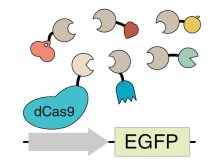BACKGROUND
Precisely controlled regulation of gene expression in cells, tissues, and organisms is one of the major challenges in tissue engineering, cell-based therapies, and gene therapy. Controlled gene expression in cells is achieved either by exogenously introducing cDNAs by transfection or viral transduction, or by introducing sequence-specific transcriptional regulators. These regulators include zinc-finger nucleases, transcription activator like effectors (TALEs), or enzymatically inactive Cas9 (dCas9) which are fused to transcriptional activation or repression domains to achieve the desired effect on gene expression. Of these techniques, CRISPR activation (CRISPRa), based on the fusion of inactive Cas9 (dCas9) to various trans-activation domains, is a powerful platform for activating gene expression. However, non-human activators (e.g. VP16) can elicit an immune response necessitating the development of human activators of comparable and tunable efficacy.
TECHNOLOGY
Researchers at the University of Toronto have discovered a set of 248 human transcription activators that can be used as part of the CRISPRa system to provide tunable protein expression for therapeutic use. These activators were isolated by conducting a genome-wide screen of ~ 15,000 human proteins to identify the top 1% of activators (Figure 1).
Figure 1. CRISPR-based chemical dimerization screen used to identify activators. dCas9 is fused to the protein phosphatase ABI1, while the potential activator (ORF) is tethered to the abscisic acid (ABA) receptor PYL1. Addition of ABA results in dimerization and initiation of EGFP transcription, with higher levels of EGFP indicative of a stronger activator. ~ 15,000 proteins were tested for activity by attaching them to PYL1.
COMPETITIVE ADVANTAGE
- ~250 activators determined for use in CRISPRa
- Tunable expression possible
- Superactivator construction possible by combining multiple complementary activators
APPLICATIONS
- Gene therapy
INTELLECTUAL PROPERTY
- Provisional patent application (Aug 2021)
PROJECT STATUS
A systematic genomic screen of 14,851 proteins was conducted to determine their potential as activators of gene expression. The top hits (248 proteins) were chosen as putative transcription activators and characterized for mechanism of action, including recruitment of cofactors and putative binding motifs.





